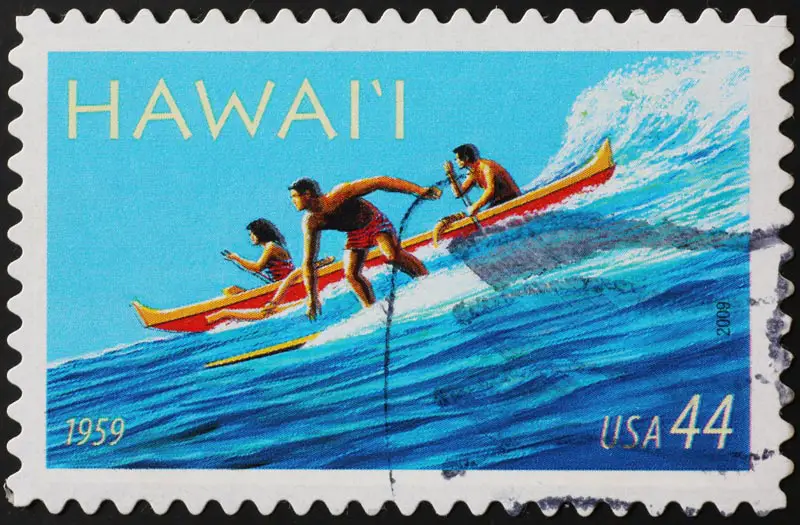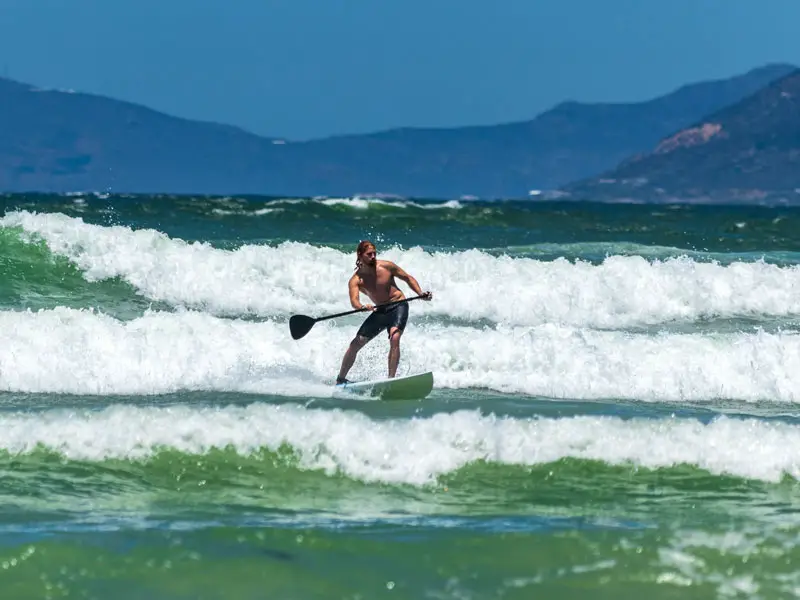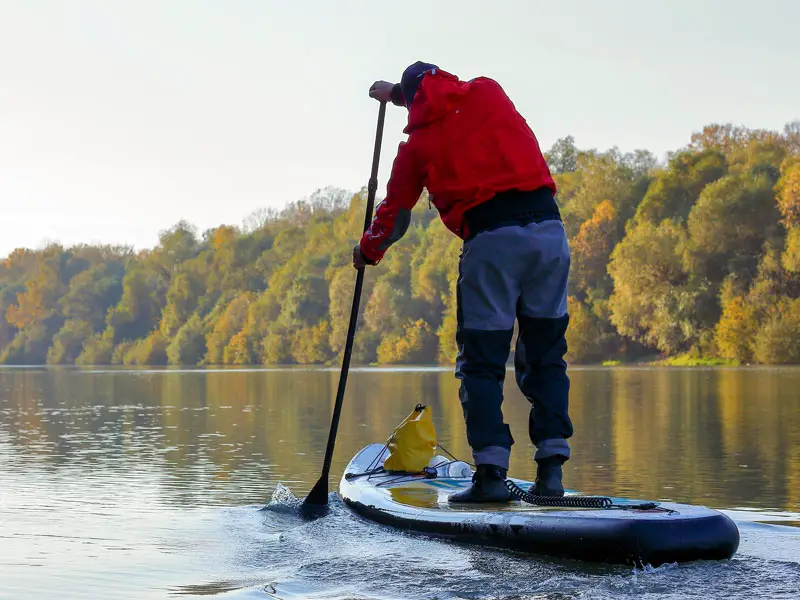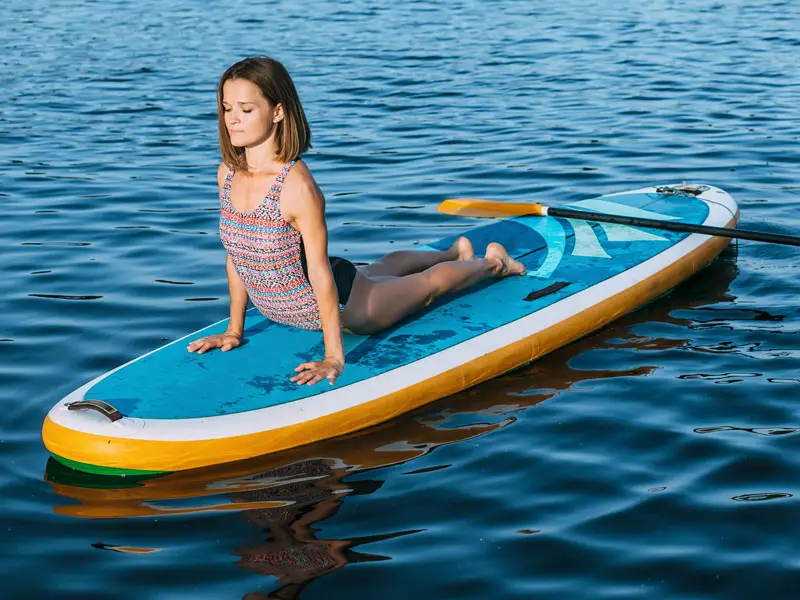Though paddle boarding in its modern iteration is relatively new and had only recently gained popularity, the history of paddle boarding reaches back into ancient times. Understanding the paddle board’s origins can foster a greater appreciation for the sport and the traditions from which it grew.
Stand up paddle boarding first came from surfing. It was originally an attempt to make surfing more accessible for people with mobility issues, who could not get up and down from surfboards easily. Later, it would come to be its own activity with many variations, of which some more closely resemble its roots in surfing than others.
Paddle Boarding’s Roots in Surfing
Given that the first paddle boards were, in fact, surfboards it’s important to recognize the contributions of the indigenous cultures that allowed for the development of the paddle board. The earliest archeological record of riding a wave using a vessel dates back three to five thousand years in pre-Inca Peru, but surfing as we know it today was developed by native Hawaiians.
Surfing in ancient Hawaii was more than just a hobby or sport. It was an integral part of their culture and viewed as an art and spiritual practice. Surfing began with a prayer to the gods for strength and protection. Occasionally, a kahuna or spiritual leader would lead a prayer asking for good surf.
The act of constructing a surfboard, too, was a spiritual practice. The surfer would carefully select a tree for wood, dig the tree out themselves, and place a fish in the hole where the tree once was as a sacrifice to the gods. Afterward, a skilled craftsman would shape the surfboard into its final product.
Surfers were often nobility or warriors. They would use their skill to gain respect and demonstrate their strength.
Surfing Culture Spreads
After European explorers found Hawaii, they began to create sugar plantations on the island and send Christian missionaries there to convert the natives. These missionaries pressured indigenous Hawaiians to abandon their traditional beliefs and practices. As a result, surfing fell in popularity.
It was only after tourists began to frequent Hawaii that surfing saw a resurgence in popularity. Tourists visiting Waikiki, a well-established surf break, occasionally saw natives surfing and tried to emulate it themselves. Eventually, native Hawaiians began to capitalize on the surfing’s newfound international attention by giving lessons and demonstrations. Specifically, a loose confederation of instructors who relaxed on the beach, surfed every day and made their money teaching rich tourists to surf. These same instructors would later popularize paddle boarding.

When was Paddle Boarding Invented
It is impossible to pinpoint when was paddle boarding invented, in part because historians have limitations on how accurately they can date events, but also because it depends exactly what you mean by paddle boarding. Here is a short timeline of paddle boarding development.
- Antiquity– There are records of stand up paddling from all over the world, from the America and Asia to Africa and Europe.
- 1094– This is the first mention of Venitian gondolas, which are paddled while standing up.
- The 1960s– Surfing is popularized all over America and John Ah Choy adapts his surf board to the first modern version of a stand up paddle board.
- 2004– Rick Thomas brings his 11 foot surf board and custom paddle to California.
- 2008– The first touring SUP board comes on the market.
Who Invented Paddle Boards?
The question as to who invented paddle boards is a complicated one because no one person really invented them. Paddle boarding as we know it today is the amalgamation of many people’s creativity.
Early and Ancient Paddle Boarding
While we can draw a direct line from the modern iteration of paddle boarding to John “Pops” Ah Choy, he was hardly the first person to come up with the idea. Many ancient cultures would stand up to paddle their vessels, including the same Peruvians who were likely the first surfers. In Africa, warriors would stand in canoes, using their spears as paddles.
John “Pops” Ah Choy
John Ah Choy, affectionately nicknamed “pops,” had been born into a family of 13 children and left school at 12 years old to work on a sugar plantation. He started his family at 18 years old and later became the father of six children. Looking to secure a more prosperous future for his children, he moved to Waikiki in 1943.
He and his children were all frequent visitors at all of Waikiki’s popular surf spots. He was a dedicated surfer, carrying 80 lb. longboards two blocks to the beach almost daily. But the journey became laborious as he aged and he would sometimes tire out before even reaching the beach.
John “Pops” Ah Choy used numerous inventive solutions to make surfboarding more convenient for him. He created a wagon to transport his longboards to the beach. He crafted his own surfboards from fiberglass skateboards. He even attached a chair to one of his surfboards so he could sit down while he was fishing.
As he aged, the act of kneeling while surfing and getting up and down to paddle the surfboard bothered his knees. At first, he began using a canoe paddle to paddle out and knee pads to lessen the pain. Eventually, he stopped kneeling altogether and just stood up while surfing. This was the beginning of stand up paddle boarding.
The Waikiki Beach Boys
Two of John Ah Choy’s sons Leroy and Bobby came to be associated with the legendary Waikiki beach boys. They competed in the Molokai Canoe Races and were personal friends with surfing celebrity Duke Kahanamoku.
They made most of their money taking pictures of tourists while they were surfing and quickly adapted their father’s invention to streamline their business. Using the vantage point of standing up, they took better photos. They also used the stand up paddle boarding technique to better monitor incoming swell. As the Ah Choy’s fellow instructors began to mimic their technique, the style garnered the name “Beach Boy Surfing.”
The Spread of Paddle Boarding
Laird Hamilton
Stand up paddle boarding had been established, but the sport’s practitioners still consisted mostly of career surfers, who were in the know. It was not until a sports journalist captured an iconic, candid photo of surfing superstar Laird Hamilton stand up paddle boarding with an American flag attached to the end of his paddle board that the sport received public attention.
Laird Hamilton was a famous big wave surfer who used stand up paddle boarding as a training method for calm days at the beach. While he didn’t do much to develop the sport himself, without his image and celebrity attached to paddle boarding, it never would have taken off.
Rick Thomas
Rick Thomas, another big wave surfing superstar, revolutionized the sport with the import of his impressive 11-foot paddleboard and custom-made paddle. He brought the board from Hawaii to California in 2004, introducing the product and the sport to the continental US.
The sport was an instant hit among experienced surfers and novices alike. It allowed for the allure of a surfboard under your feet without the geographic limitations of surfing. It provided an accessible alternative to a simultaneously popular and inaccessible sport.
New Variations
SUP Surfing
Stand up paddle boarding began as a twist on traditional surfing that allowed for greater ease and accessibility. In 2004, it was finally recognized as a legitimate sport and included in the Buffalo Big Board contest. All of the same rules of apply surfing apply, except SUP surfing allows surfers to paddle out from the shore standing up on their board. It is popular among surfers with shoulder injuries.

SUP Touring
Though this is the most popular and most accessible variation of paddle boarding today, paddle boarding on flat water only became popularized in 2007 and the first manufactured paddle boards specifically for that purpose only came out in 2008.
Nate Brouwer founded the first touring paddle board company after realizing the limitations of traditional surfing styles while exploring Lake Tahoe on his own board. He designed a paddle board for himself that could carry extra gear and his dog. The new paddle board had a more efficient glide for calm waters. He began selling the design soon afterward.

SUP Yoga
Around 2013, coinciding with an overall increase in yoga’s popularity, blogs began to pop up about yoga on stand up paddle boards. The style attracted experienced yoga practitioners who appreciated the increased intensity of the core and balance work needed for paddle board yoga. The practice forces mindfulness, as failing to maintain proper form can cause practitioners to fall into the water.

Want to know more about the different types of paddle boards? Check out our expert guide to paddle board types.
The History Of Paddle Boarding Is Still Being Written
With the sport only really starting to gain widespread popularity since 2010 and onwards, the future direction of paddle boarding is unclear. Paddle boarding is now one of the fastest growing sports in the world, and the next decade is likely to throw up some new and exciting disciplines within the sport.
The modern paddle board has a complex history. It was invented multiple times, in multiple different ways by multiple groups of people. The tale of the modern paddle board is the story of one man’s ingenuity and its intersection with thousands of years of history. Connecting with the history of paddle boarding both allows for a deeper connection with the activity and a recognition that everything we do is rooted in the past.
You may also be interested in Who Invented The Canoe?

